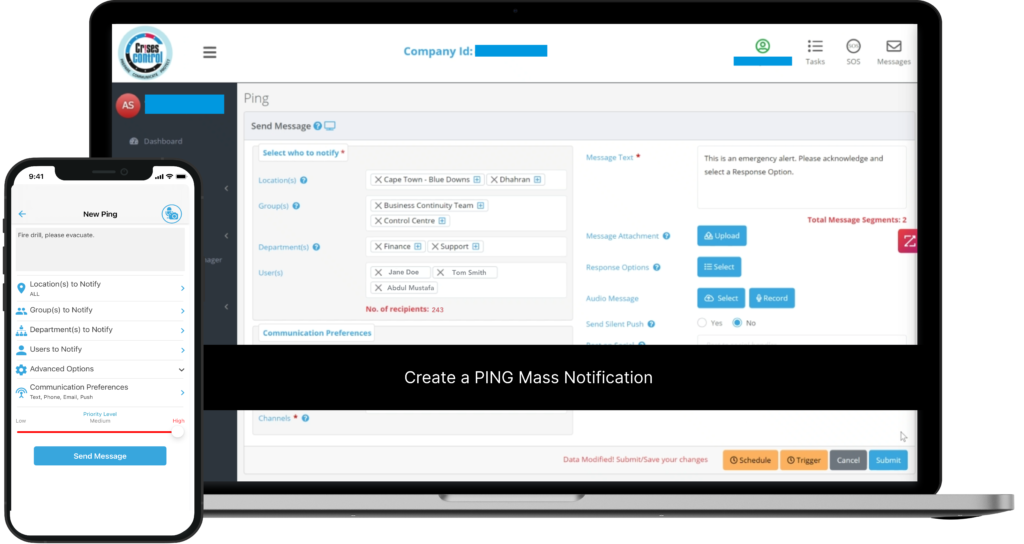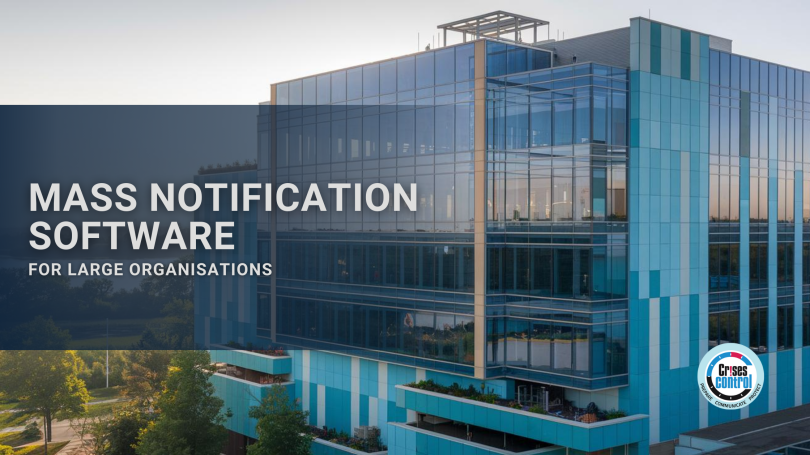Written by Anneri Fourie | Marketing Executive
In an era where crises can strike unexpectedly, the ability to communicate effectively during emergencies is paramount for large organisations. A Mass Notification System (MNS) acts as a lifeline, ensuring that critical information reaches employees promptly, thereby safeguarding lives and assets. This blog delves into the vital role of mass notification systems in large organisations, showcasing real-world scenarios where timely alerts made a significant difference. Additionally, we will explore how Crises Control can empower organisations with a robust MNS that supports business continuity.
Understanding Mass Notification Systems
What is a Mass Notification System?
A Mass Notification System (MNS) is a technology platform designed to send timely alerts and notifications to large groups of people. It plays a crucial role during emergencies, providing real-time updates on incidents such as natural disasters, workplace violence, or health crises. These systems leverage multiple communication channels, including SMS, email, mobile apps, and social media, to ensure that messages reach recipients quickly and effectively.
Key Components of an Effective Mass Notification System
An effective Mass Notification System (MNS) comprises several essential features that enhance its functionality:
- Multi-Channel Communication: The ability to send messages through various platforms ensures recipients receive alerts via their preferred method. Whether through a text message, email, or a notification on a mobile app, the goal is to ensure no one is left uninformed.
- Automated Messaging: Automated alerts can be triggered by specific events, allowing organisations to communicate swiftly without manual intervention. This is particularly important in emergency situations where every second counts.
- Integration Capabilities: Seamless integration with existing systems enhances operational efficiency, enabling organisations to leverage their current infrastructure. This means that businesses can implement an MNS without overhauling their entire communication system.
- User-Friendly Interface: An intuitive platform ensures that all employees can access and utilise the system, reducing the likelihood of miscommunication during crises. If employees find the system easy to use, they’re more likely to engage with it.
The Critical Role of Mass Notification System in Large Organisations
Timely Alerts and Response
During emergencies, every second counts. A well-implemented mass notification system(MNS) enables large organisations to disseminate information quickly, facilitating rapid responses. For example, during a fire alarm, an MNS can notify employees to evacuate the premises immediately, significantly reducing the risk of injuries or fatalities.
Enhancing Workplace Safety
Creating a safe work environment is paramount for large organisations. An MNS serves as a proactive measure, ensuring employees are informed about potential threats. For instance, in the event of an active shooter situation, timely notifications can direct employees to safe areas while providing updates on the situation as it unfolds.
Moreover, MNS can keep employees informed about natural disasters, extreme weather conditions, or other unforeseen events, allowing them to take necessary precautions before a situation escalates.
Protecting Assets and Operations
In addition to safeguarding employees, a mass notification system plays a vital role in protecting physical and digital assets. For example, during a cybersecurity breach, an MNS can alert IT teams to take immediate action, minimising potential damage. Furthermore, effective communication during natural disasters ensures that operations can resume swiftly once the threat has passed, ultimately protecting the organisation’s bottom line.
When a major incident occurs, the ability to inform employees about safety procedures and operational changes can prevent costly delays and ensure business continuity.
How Crises Control Can Help
Comprehensive Mass Notification System
Crises Control offers a state-of-the-art Mass Notification System tailored for large organisations. Our platform enables real-time communication across multiple channels, ensuring that your team stays informed during emergencies. With the ability to send alerts via SMS, email, phone calls and the mobile app, Crises Control ensures that critical information reaches employees wherever they are.
User-Friendly Interface
We understand that clarity is key during emergencies. That’s why Crises Control’s platform features an intuitive interface that allows all employees to receive and respond to alerts with ease. Whether your team is in the office, working remotely, or on the go, our MNS is designed to facilitate effective communication in any situation.
- Mobile Accessibility: Employees can receive notifications directly on their mobile devices, ensuring they’re informed even if they’re away from their desks.
- Multi-Language Support: In a diverse workplace, the ability to communicate in multiple languages ensures that every employee receives important information, fostering a sense of inclusion and safety. Crises Control supports English, Arabic, Spanish, French, Polish, Italian, and Turkish, enabling organisations to reach their entire workforce effectively. This multilingual capability not only enhances comprehension, but also empowers employees from different backgrounds to stay informed and safe during emergencies.
Customisable Alerts and Integration
Our mass notification system allows organisations to customise alert messages to suit their unique needs. This flexibility ensures that notifications are relevant and resonate with your team. For instance, organisations can tailor messages based on specific departments, locations, or types of incidents.
Additionally, Crises Control seamlessly integrates with your existing systems, enhancing operational efficiency and ensuring a smooth implementation process. This means you can start leveraging the benefits of an MNS without significant disruption to your current operations.
Training and Support
Implementing a mass notification system is just the beginning. Crises Control is committed to providing ongoing training and support, ensuring that your organisation can utilise the system effectively. Our expert team is always available to assist with any questions or challenges that may arise.
Interested in our Ping Mass Notification Software?
Efficiently alert everyone in seconds at scale with our Mass Notification System – PING, get the message out fast and ensure rapid response and recovery.

Conclusion
In today’s fast-paced environment, the need for a reliable mass notification system in large organisations cannot be overstated. With the ability to communicate effectively during emergencies, organisations can protect their most valuable assets—their employees—while safeguarding operations and business continuity.
Investing in a robust MNS is not just about compliance; it’s about creating a culture of safety and preparedness within your organisation. A well-implemented system can make the difference between chaos and control when crises arise.
If your organisation is ready to enhance its emergency communication capabilities, Crises Control is here to help. Contact us today to schedule a free demo and discover how our mass notification system can be the lifeline your organisation needs during crises.
Request a FREE Demo

